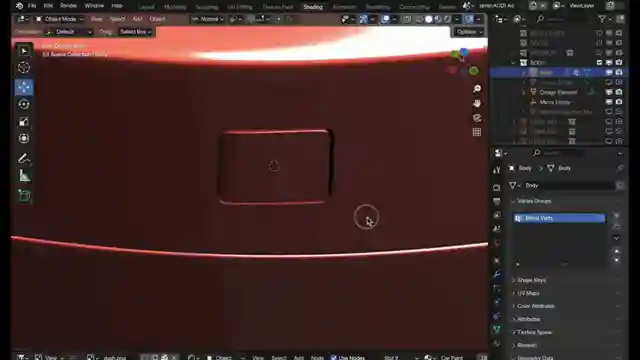Mastering 3D Surface Shading: Data Transfer vs. Shrink Wrap

- Authors
- Published on
- Published on
In this riveting video from Christopher 3D, the team delves into the intricacies of data transfer for surface shading, tackling viewer suggestions on the shrink wrap modifier. They showcase how data transfer pulls normals from a mesh, a technique commonly used by modelers to generate normals for polygon mesh data in applications like Blender. The discussion highlights the essence of NURBS applications, where mathematically perfect surfaces are converted into polygon structures with varying resolutions based on tessellation rates. Despite lower tessellation resulting in crude polygon meshes, the application calculates normals from the original NURBS data, not the resulting mesh's vertex normals.
The team demonstrates the impact of turning off data transfer, revealing geometry issues that prompt an exploration of the shrink wrap modifier as a potential solution. While the shrink wrap modifier can flatten or wrap polygons to an object, it falls short in fully resolving shading issues due to the triangle-based normal calculations. By applying shrink wrap to the cage geometry, some improvements in accuracy are observed, but glitches persist, showcasing the limitations of this method. The comparison between using data transfer and shrink wrap highlights the superiority of data transfer in achieving a smooth surface finish over the shrink wrap method.
Despite criticisms of complexity, the team emphasizes the potential of a combined approach using both data transfer and shrink wrap for precise geometry. They debunk the notion that setting up these modifiers is overly challenging, emphasizing the ease of the process once familiar with it. By showcasing the benefits of mixing both techniques, the video concludes that a hybrid approach can offer the best results, as evidenced by the comparison showing the near-perfect finish achieved with data transfer.

Image copyright Youtube

Image copyright Youtube

Image copyright Youtube

Image copyright Youtube
Watch Is using Shrinkwrap a better solution to Data Transfer for surface irregularieis? on Youtube
Viewer Reactions for Is using Shrinkwrap a better solution to Data Transfer for surface irregularieis?
Request for videos on hair or fur modeling
Comparison between using shrinkwrap and data transfer for mesh corrections
Curiosity about modeling methods used in game studios like Gran Turismo or Forza
Discussion on the effectiveness of shrinkwrap in removing pinching artifacts
Challenges with shrinkwrap picking up flipped normals or "poly cancer" from previous meshes
Differences in portability between applying shrinkwrap and data transfer
Suggestion to use a combination of shrinkwrap and data transfer for best results
Humorous comment on the term "irregularieis" sounding like a Harry Potter spell
Criticism on the use of subd modeling for hard surface objects
Critique on the video's approach and perceived lack of value for a broader audience
Related Articles

Master Blender Workflow: Bevel Modifier, Limited Dissolve & Object Changes
Discover workflow efficiency tips in Blender! Learn about using the bevel modifier for angled edges, limited dissolve for bezier curves, and applying changes to multiple objects simultaneously. Master 3D modeling tricks for seamless design.

Mastering Direct Polygon Modeling: Retro Camera Tutorial
Discover the power of direct polygon modeling vs. subdivision surfaces in mechanical modeling with Christopher 3D. Learn how to import Adobe Illustrator profiles into Blender, tackle tessellation challenges, and master precision modeling techniques to create a stunning retro camera model.

Mastering UV Mapping for Design Precision
Learn how Christopher 3D's UV mapping technique establishes precise physical sizes for design work, ensuring uniform texel density and accurate printing outcomes.

Master UV Mapping in Blender: Tips for Precise Texture Application
Learn UV mapping in Blender with Christopher 3D: establish object sizes, apply checkerboard patterns, maintain texture consistency, project UVs, add seams for closed objects. Master precise mapping for professional design projects.
